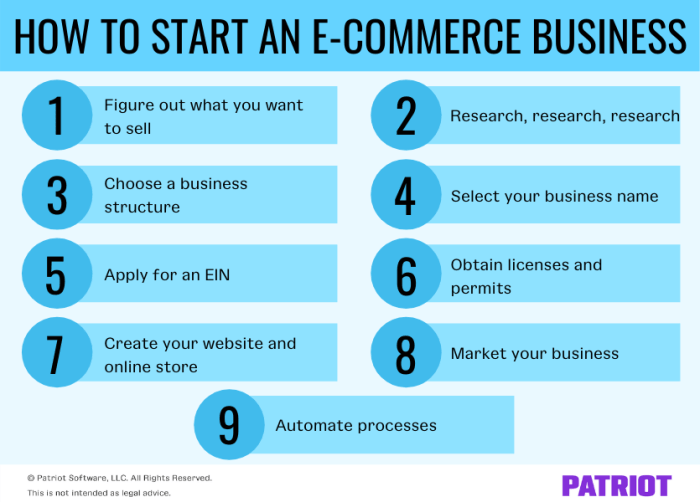Kicking off with How to Start an E-commerce Business, this guide is all about helping you navigate the ins and outs of launching your online biz. From market research to setting up shop, we’ve got you covered.
Research and Planning
Before diving into the world of e-commerce, it’s crucial to conduct thorough market research and create a solid business plan to set yourself up for success.
Importance of Market Research
Market research is vital in understanding your target audience, identifying competitors, and determining the demand for your products or services in the e-commerce industry. It helps you make informed decisions and tailor your strategies to meet the needs of your customers.
- Utilize tools like Google Trends, SEMrush, or Ahrefs to analyze search trends and s related to your products.
- Conduct surveys, focus groups, or interviews to gather feedback from potential customers and gain insights into their preferences.
- Study competitor websites, social media presence, and customer reviews to identify gaps in the market and areas where you can differentiate your business.
Significance of Creating a Business Plan
A well-thought-out business plan serves as a roadmap for your e-commerce venture, outlining your goals, target market, marketing strategies, financial projections, and more. It helps you stay focused, track your progress, and secure funding if needed.
- Define your business model, pricing strategy, and unique selling proposition to stand out in the competitive e-commerce landscape.
- Set achievable milestones and timelines to measure your success and make adjustments as needed.
- Include a detailed budget covering expenses like website development, marketing, inventory, and shipping to ensure financial stability and growth.
Choosing a Niche

When starting an e-commerce business, one of the most crucial decisions you’ll make is choosing a niche. Your niche will determine your target audience, the products you sell, and the overall success of your business. Here’s how you can select the perfect niche for your e-commerce venture.
Identifying Profitable Niches
To identify profitable niches in the market, start by researching popular trends, customer demands, and gaps in the market. Look for niches with high demand but low competition to maximize your chances of success. Utilize research tools, social media trends, and competitor analysis to pinpoint lucrative niches that align with your interests and expertise.
- Use tools like Google Trends and Planner to identify search volume for specific niches.
- Monitor social media platforms to gauge interest and engagement in different niche markets.
- Analyze your competitors to understand their strengths and weaknesses in various niches.
- Consider your own passions and knowledge when selecting a niche to ensure long-term commitment and enthusiasm.
Remember, a profitable niche is not just about high demand but also about your ability to stand out and provide unique value to your target audience.
Advantages of Focusing on a Specific Niche
Focusing on a specific niche rather than selling a wide range of products offers several advantages for your e-commerce business. By honing in on a niche market, you can:
- Build a strong brand identity and reputation within a specific industry.
- Establish yourself as an expert in your niche, gaining trust and loyalty from customers.
- Target a more defined audience, leading to higher conversion rates and customer retention.
- Efficiently market your products to a niche audience, reducing advertising costs and increasing ROI.
- Adapt quickly to market changes and trends within your niche, staying ahead of the competition.
Setting Up the Online Store
Setting up an e-commerce website involves several key steps to ensure a smooth and successful launch of your online store. From choosing the right platform to designing a user-friendly interface, each step is crucial in creating a seamless shopping experience for your customers.
Choosing the Right E-commerce Platform
When it comes to selecting an e-commerce platform for your online store, there are several options to consider. Popular platforms like Shopify, WooCommerce, and BigCommerce offer a range of features and customization options to suit your business needs. It’s essential to evaluate factors such as pricing, ease of use, scalability, and integration capabilities before making a decision.
- Shopify: Known for its user-friendly interface and extensive app store, Shopify is an excellent choice for beginners looking to quickly set up an online store.
- WooCommerce: Built on WordPress, WooCommerce provides flexibility and customization options for businesses that want full control over their online store.
- BigCommerce: Ideal for growing businesses, BigCommerce offers advanced features like multi-channel selling and built-in tools.
Choosing the right e-commerce platform is crucial for the success of your online store. Consider your business goals and requirements to make an informed decision.
Importance of User-Friendly Design and Navigation, How to Start an E-commerce Business
Creating a user-friendly design and easy navigation on your e-commerce website is essential for enhancing the overall shopping experience. Customers should be able to find products quickly, navigate through categories effortlessly, and complete their purchase without any obstacles.
- Simple Layout: A clean and organized layout with intuitive navigation menus helps customers easily find what they’re looking for.
- Mobile Responsiveness: With the increasing use of mobile devices for online shopping, ensure your website is optimized for mobile responsiveness.
- Clear Call-to-Actions: Use clear and prominent call-to-action buttons to guide customers through the buying process, such as “Add to Cart” and “Checkout.”
Product Sourcing and Inventory Management: How To Start An E-commerce Business
When it comes to running an e-commerce business, product sourcing and inventory management are crucial aspects that can make or break your success. Let’s dive into different methods for sourcing products to sell online, strategies for managing inventory efficiently, and the benefits of dropshipping versus holding inventory in-house.
Methods for Sourcing Products
- Wholesale Suppliers: Establish partnerships with wholesalers to purchase products at a discounted rate in bulk quantities.
- Manufacturers: Connect directly with manufacturers to source products at lower costs and have more control over customization.
- Dropshipping: Partner with dropshipping suppliers who handle inventory and shipping, allowing you to focus on marketing and sales.
- Online Marketplaces: Utilize platforms like Alibaba, AliExpress, or Oberlo to find a wide range of products from different suppliers.
Inventory Management Strategies
- Implement an Inventory Management System: Use software to track stock levels, sales data, and reorder points to prevent stockouts.
- Forecasting and Demand Planning: Analyze trends, seasonality, and customer demand to anticipate inventory needs and optimize stock levels.
- Just-in-Time Inventory: Minimize excess inventory by ordering products only when needed to reduce storage costs and waste.
- ABC Analysis: Classify products based on importance and prioritize inventory management efforts accordingly.
Dropshipping vs. In-house Inventory
- Dropshipping: Pros – Low upfront costs, no need to manage inventory, wider product selection. Cons – Lower profit margins, less control over shipping and quality.
- In-house Inventory: Pros – Higher profit margins, more control over quality and shipping. Cons – Higher upfront costs, storage space needed, risk of overstocking.
Marketing and Promotions

In the competitive world of e-commerce, effective marketing and promotions are essential to drive traffic to your online store and convert visitors into customers. Utilizing various strategies such as , social media, and email marketing can help you reach a wider audience and increase sales.
Strategies
- Optimize your website for search engines by using relevant s in your product descriptions and meta tags.
- Create high-quality content that is valuable to your target audience to improve your search engine rankings.
- Build backlinks from reputable websites to increase your site’s authority and credibility.
Social Media Marketing
- Utilize social media platforms like Instagram, Facebook, and Twitter to showcase your products and engage with customers.
- Create visually appealing posts and run targeted ads to reach potential customers based on their interests and demographics.
- Collaborate with influencers in your niche to promote your products to their followers and increase brand visibility.
Email Marketing Campaigns
- Build an email list of customers and prospects to send personalized promotions, product updates, and special offers.
- Create compelling subject lines and engaging content to increase open rates and drive traffic to your online store.
- Segment your email list based on customer behavior and preferences to tailor your marketing messages for better results.
Product Descriptions and Visuals
- Write detailed and persuasive product descriptions that highlight the benefits and features of your products.
- Use high-quality images and videos to showcase your products from different angles and provide a visual representation of what customers can expect.
